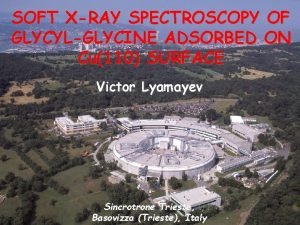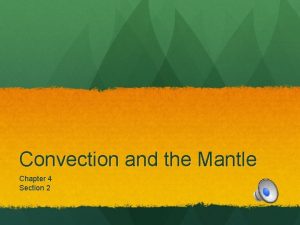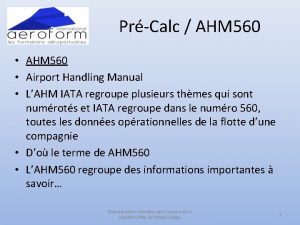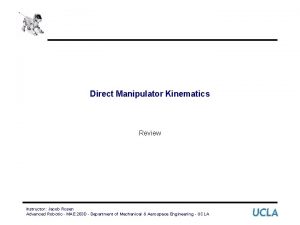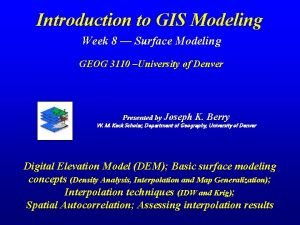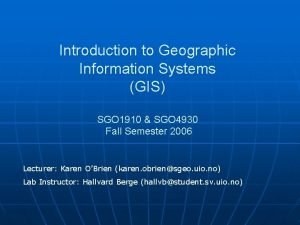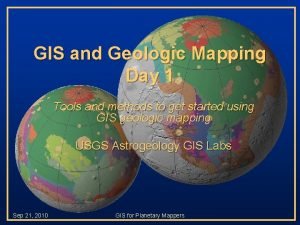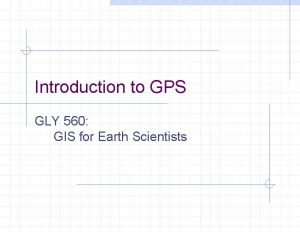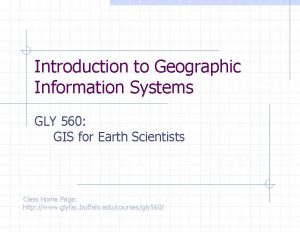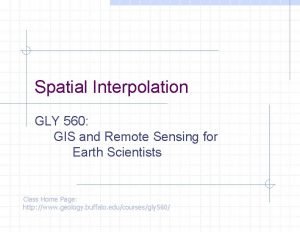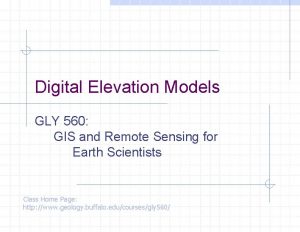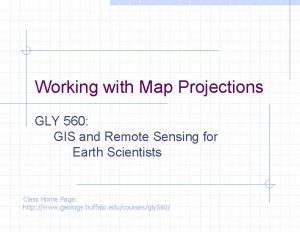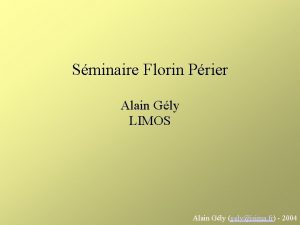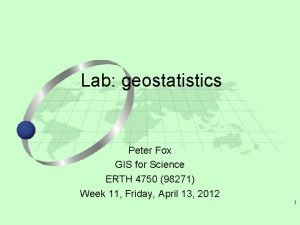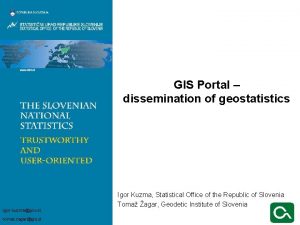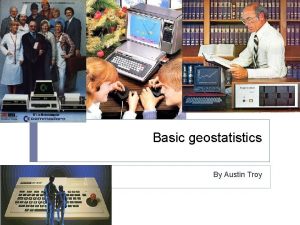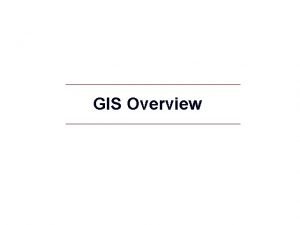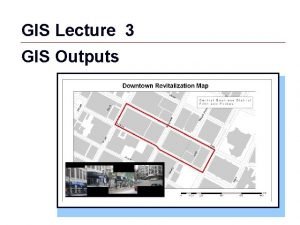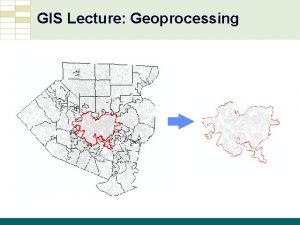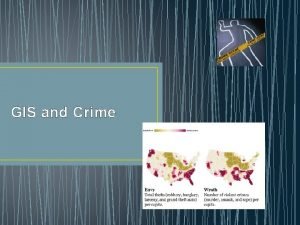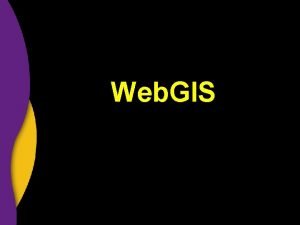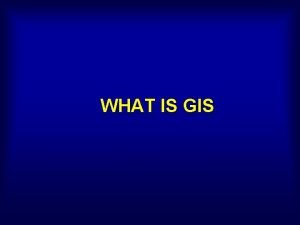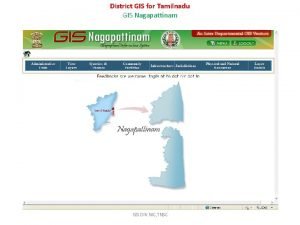Geostatistics GLY 560 GIS for Earth Scientists Introduction




















- Slides: 20

Geostatistics GLY 560: GIS for Earth Scientists

Introduction Premise: One cannot obtain error-free estimates of unknowns (or find a deterministic model) Approach: Use statistical methods to reduce and estimate the error of estimating unknowns (must use a probabilistic model) UB Geology GLY 560: GIS

Estimator of Error • We need to develop a good estimate of an unknown. Say we have three estimates of an unknown: UB Geology GLY 560: GIS

Estimator of Error • An estimator that minimizes the mean square error (variance) is called a “best” estimator • When the expected error is zero, then the estimator is called “unbiased”. UB Geology GLY 560: GIS

Estimator of Error • Note that the variance can be written more generally as: • Such an estimator is called “linear” UB Geology GLY 560: GIS

BLUE An estimator that is • Best: minimizes variance • Linear: can be expressed as the sum of factors • Unbiased: expects a zero error …is called a BLUE (Best Linear Unbiased Estimator) UB Geology GLY 560: GIS

BLUE • We assume that the sample dataset is a sample from a random (but constrained) distribution • The error is also a random variable • Measurements, estimates, and error can all be described by probability distributions UB Geology GLY 560: GIS

Realizations UB Geology GLY 560: GIS

Experimental Variogram • Measures the variability of data with respect to spatial distribution • Specifically, looks at variance between pairs of data points over a range of separation scales UB Geology GLY 560: GIS

Experimental Variogram After Kitanidis (Intro. To Geostatistics) UB Geology GLY 560: GIS

Experimental Variogram After Kitanidis (Intro. To Geostatistics) UB Geology GLY 560: GIS

Small-Scale Variation: Discontinuous Case Correlation smaller than sampling scale: Z 2 = cos (2 p x / 0. 001) After Kitanidis (Intro. To Geostatistics) UB Geology GLY 560: GIS

Small-Scale Variation: Parabolic Case Correlation larger than sampling scale: Z 2 = cos (2 p x / 2) After Kitanidis (Intro. To Geostatistics) UB Geology GLY 560: GIS

Stationarity • Stationarity implies that an entire dataset is described by the same probabilistic process… that is we can analyze the dataset with one statistical model (Note: this definition differs from that given by Kitanidis) UB Geology GLY 560: GIS

Stationarity and the Variogram • Under the condition of stationarity, the variogram will tell us over what scale the data are correlated. Correlated at any distance g(h) Uncorrelated Correlated at a max distance h UB Geology GLY 560: GIS

Variogram for Stationary Dataset Semi-Variogram function • Range: maximum distance at which data are correlated • Nugget: distance over which data are absolutely correlated or unsampled Range Sill Nugget Separation Distance UB Geology GLY 560: GIS • Sill: maximum variance (g(h)) of data pairs

Variogram Models UB Geology GLY 560: GIS

Kriging • Kriging is essentially the process of using the variogram as a Best Linear Unbiased Estimator (BLUE) • Conceptually, one is fitting a variogram model to the experimental variogram. • Kriging equations may be used as interpolation functions. UB Geology GLY 560: GIS

Examples of Kriging Universal Exponential UB Geology GLY 560: GIS Circular

Final Thoughts • Kriging produces nice (can be exact) interpolation • Intelligent Kriging requires understanding of the spatial statistics of the dataset • Should display experimental variogram with Kriging or similar methods UB Geology GLY 560: GIS
 Ligand isomerism
Ligand isomerism Gly
Gly Gly
Gly Scientists think that convection currents flow in earth's *
Scientists think that convection currents flow in earth's * 200 ün 6 fazlası kaçtır
200 ün 6 fazlası kaçtır Ahm 560 manual
Ahm 560 manual Ba 560
Ba 560 Ahm560
Ahm560 560*.75
560*.75 Ventilador puritan bennett 560
Ventilador puritan bennett 560 Kinematics robot
Kinematics robot 560 000 in scientific notation
560 000 in scientific notation Introduction to gis
Introduction to gis Introduction to gis
Introduction to gis Gis
Gis Iso 22301 utbildning
Iso 22301 utbildning Novell typiska drag
Novell typiska drag Tack för att ni lyssnade bild
Tack för att ni lyssnade bild Returpilarna
Returpilarna Varför kallas perioden 1918-1939 för mellankrigstiden
Varför kallas perioden 1918-1939 för mellankrigstiden En lathund för arbete med kontinuitetshantering
En lathund för arbete med kontinuitetshantering


